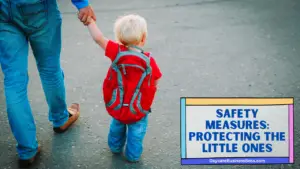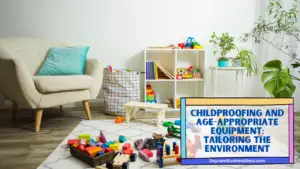The Family Daycare Inspection Checklist is a useful tool in the field of childcare, where the safety, development, and happiness of children are paramount. As parents entrust their precious children to the care of childcare providers, maintaining the highest quality standards becomes a joint obligation.
The best way to ensure quality in family daycare is to follow a checklist, which includes safety measures in place, a clean and hygienic environment, childproofing and age-appropriate equipment, a proper caregiver-to-child ratio, and documentation of policies and emergency procedures.
This article examines the significance of the Family Daycare Inspection Checklist, shining light on its role in providing a safe, sanitary, and enriching environment for children’s development. Join us as we explore the many elements of this checklist, revealing its critical role in molding the experiences of children under the care of devoted professionals in the field of family daycare.
Safety Measures: Protecting the Little Ones

In every childcare setting, safety is vital, establishing the foundation upon which a nurturing and secure environment for children can be formed. The foundation of such an environment is a precisely constructed checklist that includes a wide range of severe safety precautions. The major purpose of this checklist is to protect children from any threats and to assure their well-being while in daycare.
One of the most important components of this safety checklist is addressing physical risks that could endanger children’s safety. This includes taking precautions such as covering electrical outlets to prevent inadvertent shocks, keeping sharp objects out of reach of youngsters, and rigorously inspecting the environment for choking risks. These steps demonstrate a proactive approach to protecting children from immediate threats that may exist in their environment.
The checklist’s purview extends beyond the physical sphere to include potential emergency circumstances. It requires the development of thorough fire escape plans that take into account the layout of the facility as well as the quickest and safest methods to evacuate children in the event of a fire outbreak. The checklist emphasizes the significance of keeping emergency contact information up to date to facilitate fast connection with parents or guardians during critical situations. A well-stocked and periodically checked first-aid kit is a vital component of the checklist, allowing caregivers to treat minor injuries quickly and effectively.
Adhering to a safety-focused checklist benefits family daycares in a variety of ways. First and foremost, it greatly decreases the possibility of accidents occurring on the daycare grounds. This, in turn, creates trust among parents and guardians, ensuring them that their children are in capable and well-protected hands. The extensive scope of the checklist also indicates the daycare’s commitment to maintaining the highest safety standards, reinforcing its reputation as a dependable and responsible childcare provider.
The major result of a properly constructed safety checklist is the establishment of a haven for children’s growth and development. Caregivers create an environment in which children can explore, learn, and play without fear by systematically addressing both the immediate and potential hazards connected with childcare situations. As long as children’s safety is prioritized, their physical, emotional, and cognitive development can occur naturally, allowing them to thrive in an atmosphere that values their well-being.
Read more about: Unlocking Doors of Opportunity: The Proven Steps to Opening a Daycare
Clean and Hygienic Environment: Fostering Health and Wellness
Maintaining a clean and sanitary environment is critical to ensuring the physical well-being of children in any setting. This responsibility is especially important in places like daycare centers, where children’s vulnerability to germs and diseases needs a strict attitude to clean. An effective checklist emerges as a critical instrument in this quest, including a variety of behaviors that work together to promote a safe and healthy environment for children’s development.
The development of regular cleaning regimens is at the heart of our cleanliness-centric checklist. A well-organized schedule that specifies when and how certain places and items should be cleaned improves consistency in cleaning efforts. Every action, from wiping down surfaces to cleaning floors, helps to keep dust, filth, and other pathogens at bay. Caregivers actively contribute to keeping an atmosphere that is not only visually pleasing but also free of dangerous agents that could jeopardize the children’s health by sticking to these schedules.
Effective waste disposal practices are an important component of the checklist. Making sure garbage cans are adequately lined and emptied on time reduces the possibility of bacteria growth and foul odors. This vigilance extends beyond the local indoor regions to include outside settings as well, developing a holistic approach to keeping the environment clean and organized.
Sanitation techniques, such as thorough handwashing and regular disinfection of frequently handled surfaces, are also included in the checklist. These activities operate as a barrier against the spread of germs and illnesses, which can easily spread in places with high levels of interaction. Caregivers can dramatically minimize the spread of infections among children by incorporating such techniques into their everyday activities.
In the context of a childcare setting, the checklist broadens its scope to include specific areas that are critical to children’s daily activities. Toys, play areas, eating areas, and restrooms are all beautifully maintained. Toys are cleaned and sanitized regularly to prevent the accumulation of germs that children may come into contact with. Play areas are meticulously cleaned to provide a safe environment for children to explore and engage in imaginative play. To prevent the consumption of dangerous pathogens, eating areas where children consume their meals and snacks are cleansed. Restrooms, another crucial location, are kept clean and sanitary to avoid the transmission of diseases and assure the comfort of youngsters.
Adhering to a cleaning checklist is more than just a chore; it has the potential to have a substantial impact on the well-being of the children under a caregiver’s care. Caregivers establish a sense of security and trust among parents and guardians by maintaining an atmosphere devoid of potential causes of illness and discomfort. Youngsters thrive in a physically pleasant setting that is beneficial to learning and growth.
Childproofing and Age-Appropriate Equipment: Tailoring the Environment

Childproofing and the provision of age-appropriate equipment are two essential components of a comprehensive childcare checklist. This dual approach combines proactive safety precautions with thorough consideration of children’s developmental requirements, resulting in an atmosphere that fosters both their well-being and growth.
The first component of this method, childproofing, entails a thorough examination and mitigation of possible hazards in the daycare setting. The checklist should include eliminating sharp edges, securing tiny objects that could pose choking hazards and identifying and correcting any other potential causes of injury. This vigilant approach protects against mishaps, allowing youngsters to explore and connect with their surroundings without putting themselves in danger.
The inclusion of age-appropriate equipment demonstrates the checklist’s dedication to promoting children’s overall development. Recognizing that each age group has unique cognitive, physical, and emotional needs, the checklist pushes for the availability of equipment that corresponds to these stages. Cribs with safety features, high chairs with suitable restraints, and playsets meant to improve certain motor skills are just a few examples of equipment that should be carefully selected based on the ages and developmental stages of the children.
Age-appropriate equipment is also important in the area of educational materials. The checklist’s effect should be felt in the selection of toys, books, and learning instruments that cater to the cognitive development of the children. Materials that foster curiosity, imagination, and problem-solving abilities can be incorporated, resulting in a dynamic and interesting learning environment.
The checklist’s primary focus is not on high-quality educational materials and equipment; rather, it focuses on assuring their safety. The concepts of childproofing apply here as well since the chosen equipment should be evaluated for potential hazards and carefully maintained. Regular examinations for wear and tear, loose parts, and other safety concerns are critical to maintaining the environment’s integrity.
Daycares establish a space where safety and growth coexist happily by adhering to a checklist that includes both childproofing and the supply of age-appropriate equipment. Parents and guardians take comfort in knowing that their children are in a setting that prioritizes their safety and well-being while simultaneously encouraging their learning and growth. A healthy balance of these two features is essential; an extremely sterile atmosphere devoid of age-appropriate equipment may stifle a child’s curiosity and creativity, whereas an inadequately childproofed room may expose them to avoidable risks.
Read more about: Unlocking Potential: Free Online Courses for Quality Childcare Provision
Proper Caregiver-to-Child Ratio: Individualized Attention
Maintaining an adequate caregiver-to-child ratio is essential for effective childcare since it has a direct impact on the quality of care and attention that each kid receives. A well-structured checklist is critical in establishing and maintaining this ratio, which is guided by age, developmental stage, and the individual needs of the children under the care of a caregiver. This ratio is an important determinant in molding each child’s general well-being and progress.
Developing an ideal caregiver-to-child ratio is not a one-size-fits-all method. It necessitates a comprehensive grasp of the developmental requirements of various age groups as well as the needs of individual children. An effective checklist provides acceptable ratios that balance the number of caregivers with the number of children, based on research and best practices. This balance guarantees that each child receives the individual care and attention that they require.
Due to their limited ability to convey their requirements, infants and toddlers, for example, require more frequent and rapid care. The checklist should reflect this reality by requiring a lower child-to-caregiver ratio in this age range. However, as children grow and become more autonomous, the ratio can be modified to meet their changing needs.
A proper caregiver-to-child ratio has far-reaching consequences. It has a significant impact on children’s emotional growth and security. Caregivers who dedicate enough time and attention to each kid build a foundation of trust and emotional connection. This, in turn, develops a sense of security and belonging, allowing children to confidently explore their surroundings and participate in activities.
An ideal ratio directly helps children’s cognitive and intellectual growth. Caregivers are better positioned to notice and respond to each child’s interests, abilities, and areas in which further assistance is required. This customized approach allows for tailored learning experiences that are adapted to each child’s speed and preferences. Caregivers can tailor their tactics to the requirements of particular children, from answering inquiries and providing explanations to engaging in participatory activities.
The proper caregiver-to-child ratio also has a favorable impact on the entire ambiance of a childcare setting. When there are fewer children per caregiver, the environment becomes more structured and manageable. Caregivers have the time to keep a clean and organized environment, encourage activities, and ensure safety rules are followed. As a result, both children and caregivers benefit from a more enriching and pleasant atmosphere.
Documentation of Policies and Emergency Procedures: Preparedness and Accountability

A well-organized daycare is built on a solid foundation of detailed paperwork, which serves as the cornerstone for its commitment to safety, consistency, and professionalism. A well-crafted checklist can help ensure that rules and emergency procedures are not only developed but also easily accessible and properly implemented. This paperwork covers a variety of crucial areas, such as emergency protocols, daily routines, communication methods, and behavior management, all of which contribute to a coherent and supportive childcare environment.
The construction of clear and effective emergency procedures is at the heart of this documentation. The checklist should include precise instructions on how to respond to various emergency scenarios, ranging from small injuries to more significant catastrophes such as natural disasters or medical problems. This system relies heavily on evacuation preparations, communication protocols with emergency agencies, and directions for swiftly notifying parents. Caregivers are better equipped to negotiate high-stress situations with confidence and speed when these processes are documented and easily available, prioritizing the safety and well-being of the children in their care.
Aside from emergencies, the checklist outlines important policies that regulate the daycare’s regular activities. Meal times, nap routines, and other recurring activities are all covered by these policies. Caregivers establish consistency in care and avoid interruptions to children’s schedules by documenting these routines. This method instills a sense of stability and predictability in youngsters, which is essential for their emotional security and growth.
Another crucial aspect addressed by the checklist is communication between daycare providers and parents. Transparent and effective communication is facilitated by clear criteria for how information is communicated, whether through daily reports, newsletters, or regular meetings. Parents obtain insights into their child’s experiences, progress, and any difficulties, allowing them to stay active participants in their child’s development.
Behavior management policies are also critical. The checklist should identify tactics for encouraging positive behavior and addressing difficulties, ensuring that caregivers take a united approach. Consistency in behavior management not only fosters a controlled atmosphere but also helps children grasp boundaries and expectations, which aids in their social and emotional development.
Daycare providers demonstrate their commitment to professionalism and accountability by documenting these policies and procedures. The checklist represents a commitment to providing a secure, caring, and enriching environment for children. It signals to parents and guardians that the daycare is transparent, follows best practices, and prioritizes the well-being of their children.
Read more about: To Deduct or Not to Deduct: Childcare Costs in Business Meetings
Frequently Asked Questions

Why is it vital to use a checklist for family daycare quality assurance?
Using a checklist is essential for maintaining good standards in family daycare because it gives a systematic approach. It guarantees that critical features such as safety precautions, cleanliness practices, suitable equipment, caregiver ratios, and emergency procedures are followed continuously. This methodical strategy reduces hazards, promotes child development, and gives parents trust in the daycare’s dedication to quality.
How does a thorough checklist improve child safety in daycare settings?
A comprehensive checklist improves kid safety by highlighting particular safety precautions that must be taken. It addresses issues such as childproofing the environment, detecting and removing risks, and providing clear emergency protocols. By following these rules, daycare providers create a safe environment that decreases the likelihood of accidents and ensures the safety of the children.
How can an appropriate caregiver-to-child ratio improve a child’s daycare experience?
It is critical to maintain an adequate caregiver-to-child ratio to provide specialized care and attention. A balanced ratio guarantees that each kid’s needs are fulfilled efficiently, allowing caregivers to form meaningful connections and adjust activities to the developmental stage of each child. This promotes emotional safety, intellectual development, and pleasant social relationships, resulting in a supportive atmosphere in which children can thrive.
To learn more on how to start your own daycare checkout my startup documents here.
The information provided by DaycareBusinessBoss.com (“The Site”) is for general informational purposes only. All information on the Site is provided in good faith, however, we make no representation or warranty of any kind, express or implied, regarding the accuracy, adequacy, validity, reliability, availability or completeness of any information on the Site. Under no circumstance shall we have any liability to you for any loss or damage of any kind incurred as a result of the use of the Site or Reliance on any information provided on the Site. Your use of the Site and your reliance on any information on the Site is solely at your own risk.
This blog post is for educational purposes only and does not constitute legal advice. Please consult a legal expert to address your specific needs. Terms and Conditions. (https://daycarebusinessboss.com/terms-conditions/)

Meet Shawn Chun: Entrepreneur and Childcare Business Fan.
I’m a happy individual who happens to be an entrepreneur. I have owned several types of businesses in my life from a coffee shop to an import and export business to an online review business plus a few more and now I create online daycare business resources for those interested in starting new ventures. It’s demanding work but I love it. I do it for those passionate about their business and their goals. That’s why when I meet a childcare business owner, I see myself. I know how hard the struggle is to retain clients, find good employees and keep the business growing all while trying to stay competitive.
That’s why I created Daycare Business Boss: I want to help childcare business owners like you build a thriving business that brings you endless joy and supports your ideal lifestyle.

